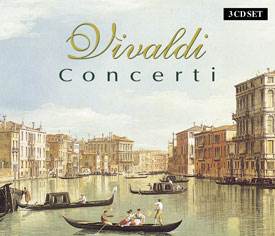Vivaldi, himself a violinist, has survived magnificently
into the 20th century due mainly to his prolific output
of concertos – over 230 for the violin alone, and also
for a large number of other instruments, including chalumeaux,
clarinets and horns. He was the first composer regularly to use
the Ritornello form in which the thematic material is repeated
and elaborated between orchestra and soloist(s). This disc provides
a generous sample of his stimulating style and melodic gift. Thankfully
it does not contain the Four Seasons concertos, now hopefully
laid to rest under an enormous pile of CDs.
The Concertos for Strings are evidence that,
despite their formal similarities, Vivaldi was by no means a ‘formula’
composer. Short, repeated echo phrases and the Ritornello style
make them easily identifiable as vintage Vivaldi, but they also
contain many colourful twists and turns of phrase that please
the ear and hold the listener’s interest. Well played, and they
are here, these works are no mere ‘wallpaper music’ and attentive
listening brings its rewards. Concerto Italiano and Fabio Biondi
have the requisite bravura, though occasionally lack the subtlety
needed to make the most of their kaleidoscopic harmonic and melodic
colours.
Vivaldi’s guiding principle appears to have been
‘if it can be bowed, blown or plucked write concertos for it’.
The Chamber Concertos are more gentle and intimate than the Concerti
grossi and, except for the A minor (RV 86) – a personal
favourite with its entrancing Largo cantabile – are
written in a compact three-movement form for small ensembles.
They are well worth inclusion since they are probably the least
well known works in this collection. Vivaldi wrote around twenty,
probably for the salons of his wealthy patrons.
The Concertos for Diverse Instruments are innovative
and skilfully reflect the expressive characteristics of the various
instruments for which they were written. With their lighter scoring,
they import a feeling of relaxation to this pleasing set. The
flute concertos are particularly enjoyable and include a perennial
favourite, Il Gardellino, where the virtuoso chirping of
the goldfinch (in Italy named ‘the little cardinal because of
its red ‘cap’) offers tempting opportunities for free ornamentation,
confidently accepted by the soloist. His clean-limbed performance
is ably matched by Marion Moonen in the concerto for two traversi.
The set is remastered from recordings made in
the late 1980s and early 1990s when accomplished Vivaldi playing
was less frequently encountered than it now is. Nevertheless this
set merits comparison with the best of today’s performances. I
am reliably informed that the absence of an insert booklet in
the review copy is not accidental: there simply isn’t one. If
so – and in view of the sparse information on the CD case
– that is an unfortunate omission.
Roy Brewer


